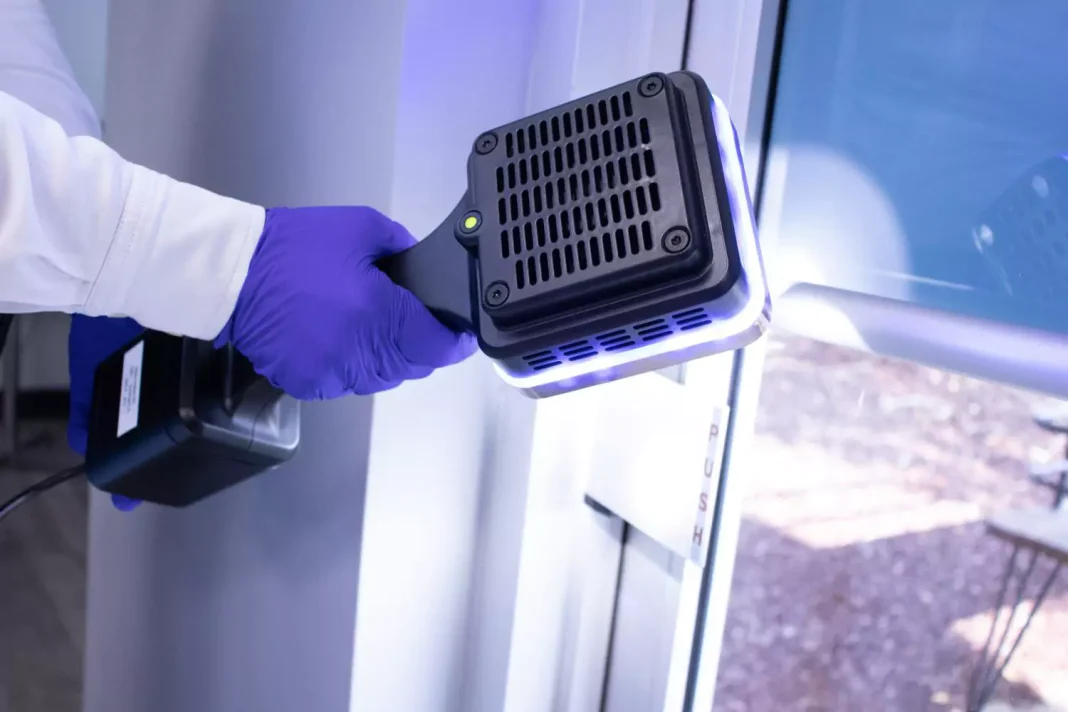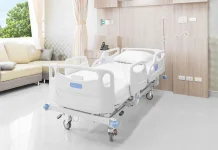Castine A. Bernardy, Nicola M. Elardo and Alexa M. Trautz, Department of Civil and Environmental Engineering, University of New Hampshire, Durham, New Hampshire
Corresponding author James P. Malley, Jr., Department of Civil and Environmental Engineering, University of New Hampshire, Durham, New Hampshire
Worldwide concern over the risk of contracting or spreading COVID-19 has sparked widespread and increasing interest in using UV devices for air and surface disinfection. In the relatively short period of time between mid-March and the writing of this article in mid-November, worldwide estimates show a doubling or perhaps tripling of activity in the development and sales of UV devices.
These UV devices operate over a range of conditions from intermittent to continuous to varying temperatures and relative humidity resulting in a different range of constraints than have been traditionally experienced in the applications of UV devices to the “water” field. In particular, the ability to employ much longer contact times and operate intermittently and/or on much smaller volumes of air or surfaces that traditional water UV systems have had to treat opens up the possibilities for these other sources. For these and many other reasons, this reveals new opportunities for the application of mercury-free germicidal ultraviolet light sources.
The search for light sources that are cost-effective (efficiency and life), more sustainable, energy efficient and environmentally friendly (or green), and, therefore, more socially acceptable has been underway for decades, if not since the beginning of the illumination (light) science and engineering profession. There have been dozens of alternative mercury-free, UV light sources examined at all stages of research and development. This so-called triple bottom-line approach to assessing sources of germicidal UV light is highly recommended and will be employed in this discussion.
For numerous pragmatic reasons, this article needs to focus on a limited number of sources that are commercially available and show the most near-term promise for UV disinfection. Therefore, the following discussion will include UV LEDs, excimer lamps (e.g., krypton-chlorine systems producing so-called far UV-C light) and xenon flash lamps (often referred to as pulsed UV-C systems). The performance of virtually all illumination sources, including UV, is a function of QA/QC during product manufacture, power quality experienced during operating life and response to a number of thermal, physical, chemical and biological stresses experienced during use.
Defining UV light
Buyers and users need to familiarize themselves in some fashion with the different types of UV, including UV-A (wavelength: 315 to 400 nm), UV-B (wavelength: 280 to 315 nm), UV-C (wavelength: 200 to 280 nm) and Vacuum UV (wavelength: 100 to 200 nm).
The wavelength ranges given here are based upon IUPAC Gold Book-2020, and for the discussion of disinfection by these UV devices, UV-C wavelengths that should be focused on. A subset of UV-C that has received some recent attention is far UV-C (200 to 225 nm), and this, at times, is vaguely and incorrectly simply called far UV. This article will not discuss other light sources producing non-UV wavelengths that may be applicable to certain types of disinfection or sterilization systems.
In general, the lower the wavelength the more energy in the photons of light wave energy being employed by the device. When discussing the disinfecting power of sunlight, normally this means talking about a mixture of approximately 95% UV-A and 5% UV-B. Given enough time (days) these wavelengths surely have many effects, but it is a long timeframe and many other factors come into play, such as desiccation of the organisms on a surface, etc. There are many benefits to sunlight and fresh air, but sunlight is generally not considered as a practical disinfection option due to long timeframes.
All sources of UV light have pros and cons, and careful consideration of which UV wavelengths are being used and for what purpose must be done. Dosing human and animal tissue with any forms of UV light – based upon the current level of understanding of potential health effects and guidance from health professionals – should not be done by buyers and users of these UV devices. Special cases performed by experienced medical professionals under very tightly controlled conditions for very specific medical problems may be found in internet searches, but DO NOT DO THIS AT HOME is the best message for all buyers and users of UV devices.
UV LEDs
Light-emitting diodes (LEDs) are semiconductor light sources that emit light when current flows through them from the anode (n-type) to the cathode (p-type). Electrons in the semiconductor recombine with electron holes, releasing energy in the form of photons. Information on UV LEDs presented here is based upon current literature and UV LED experts in the IUVA. A special acknowledgement is made to Dr. Richard Simons, whose mentoring of the authors, as well as his recommendation to begin with the reference “The UV Emitter Roadmap,”1 proved vital to this article. Readers interested in getting a broad initial perspective on the large and ever-changing field of UV LEDs are urged to consult experts in the field and review the aforementioned article.
As previously published in UV Solutions, there is a lack of validation and certification, so the buyer and user need to beware of misleading or completely erroneous claims being made by some disinfection technologies during the COVID-19 pandemic. That includes devices using UV LED technologies. IUVA members and many others have published and presented widely on the promise that UV LEDs could bring to the profession, including an almost unlimited array of geometric designs for devices, promise of long operating lives and a recyclable and mercury-free light source.
The promise of LEDs, and specifically UV LEDs, has been growing for more than 40 years. Several challenges have been overcome, resulting in UV-C efficiencies first exceeding 1% and with an achievable goal of 10% by 2022. These advances have allowed rapid growth in recent years – especially during the COVID-19 pandemic – of commercial devices that rely upon UV LEDs. Promising UV LED efficiencies were first realized in the UV-B range. Similarly, work in the past three years has given rise to several devices making use of 275 nm UV LEDs. Increasing research and improving forecasts in efficiencies and life also have seen growth in devices using UV LEDs that emit in the 265 nm range. It is recognized in the UV LED literature that other wavelengths – such as 254 nm, 222 nm, 210 nm, etc. – can be produced, but as wavelength decreases, there are significant challenges to attaining efficiencies and reasonable lives of these light sources that would render them truly commercially competitive.
In UV LED systems, the potential life of the LEDs can vary significantly but shows great promise to exceed 10,000 hours with some anecdotal information suggesting 25,000 hours could be achieved. The UV LED research suggests the higher drive currents (e.g., 700 mA vs. 350 mA) or desire to produce UV wavelengths below 275 nm will result in significant degradation of UV-C output in the first 1,000 hours of operation.
For a variety of applications, the overall sentiment expressed in the literature suggests that UV LEDs will become the leading source of germicidal light in many commercial devices by 2022. There remain many UV LED challenges, especially for applications desiring lower wavelengths (e.g., below 275 nm), combined with longer lives and higher UV-C energy efficiencies, that might rival the conventional mercury vapor germicidal UV sources (e.g., 30%). For similar reasons, the applications of UV LEDs to larger capacity devices or larger flow through devices treating air or other fluids will likely require new advances in the technology, which may take many years depending upon the level of research and development interest and funding that is available. The cost per milliwatt of UV-C irradiance for UV LEDs has always been a major limitation for the commercialization of larger products and remains highly variable. However, as widespread use grows, in many categories historical trends in lighting and in sister products relying upon blue UV LEDs suggest that economy of scale advantages will work to drive costs down. In many applications, these UV LEDs should become cost competitive.
Krypton-chlorine excimer lamps
The illumination field has worked with excimer lamps for more than 50 years. A broad understanding of UV excimer lamps can be obtained by reviewing the article “Development and Applications of UV Excimer Lamps.”2 The term “excimer” arguably emerged in the 1960s as a concise form of describing excited dimers of the noble gases. Although dozens of potential excimer lamp mixtures have been created, a great deal of early work focused on xenon dimers (Xe2) and, more recently, lamp technologies have explored heterodimeric bonds between noble gases and halogens, which are often referred to in the literature as exciplexes.
UV light is generated by excimer type lamps when electrical energy excites the gas molecules in the lamp, giving rise to a plasma containing in part short-lived complexes (dimers) that – when they return to their ground state – emit light energy in a range of UV wavelengths. In the interest of brevity this discussion will focus on krypton-chlorine (also called krypton-chloride) lamps often called excilamps because the UV disinfection literature has seen a growing body of promising research and commercial interest in lamps producing far UV-C light, primarily at 222 nm.
As of this writing, one of the most promising methods of generating 222 nm UV-C light is through an optically filtered KrCl source. The 222 nm UV sources are found in two categories as of this writing, conventional commercially available lamps that are cylindrical (tubular) and have been produced and applied in industry for many years, or a recent innovation producing 222 nm from flat ultraviolet lamps made possible through patented microcavity, microplasma excimer technology.3
At present, there is far less user experience in terms of lamp life, UV-C efficiency and output, but in several studies stability has been shown for at least 4,000 hours and predictions suggest lamp life and efficiency with additional research and development would be similar to low-pressure mercury vapor systems. The cost per milliwatt of UV-C irradiance for KrCl sources remains significantly higher than for conventional mercury vapor lamps, but if widespread acceptance of far UV-C applications occurs and subsequent use grows, then historical trends in lighting products suggest that economy of scale advantages will work to drive costs down. In many applications, these KrCl sources should become cost-competitive.
The current interest and excitement relative to UV at 222 nm (aka far UV-C) stems from a number of promising peer reviewed research publications that have demonstrated the germicidal effectiveness of 222 nm UV-C while resulting in far less – perhaps insignificant – effects of this UV light on living cells of the skin and the eyes. An excellent summary of these studies, many being performed by the Columbia University researchers, can be found online.4 The IUVA COVID-19 Task Force also has published a white paper that reviews this promising research in the context of current human exposure guidelines and points out areas that warrant additional research prior to widespread adoption of this far UV-C technology for combating viral epidemics and pandemics.5
Xenon arc (flash or pulsed) lamps
Xenon arc lamps were first developed in the 1930s for applications in the photographic industry, where they developed the nickname of flash lamps. Over the years, they have been called by several names, including pulsed UV. Xenon arc lamps are specialized types of gas discharge lamps that produce light by passing electricity through ionized xenon gas at a high pressure, resulting in a broad spectrum of light output that is often said to simulate sunlight. These lamps often cycle through a series of 100 nanosecond up to two millisecond pulses producing broadband light from 180 nm to about 1,100 nm (infrared). Pulsed xenon lamps produce significant photon energy in the so-called germicidal range of 200 to 315 nm. These pulsed UV lamps have been used in disinfecting sensitive medical environments, high-traffic public areas, public transports and alternatives to thermal methods in disinfection and preservation of foods and beverages.6
Research by IUVA members7 looking at the applications of pulsed UV systems in water applications between the 1990s and present day have clearly demonstrated the ability to disinfect bacterial, viral and protozoan pathogens of concern. However, the aspects of energy efficiency, lamp life and overall UV-C output efficiency have limited the use of pulsed UV sources for large volume applications or treating significant fluid flows. Since the COVID-19 pandemic, there has been renewed interest in using pulsed UV systems sparked in part by FDA Emergency Use Authorization of these systems to treat air and surfaces, including in transportation facilities, medical facilities and the reopening of public use buildings.
There has been a limited track record for xenon-based pulsed UV lamp systems, and many performance specifications are highly dependent upon how the lamp systems are operated, so energy and UV-C efficiencies – as well as lamp lives – have varied widely in the reported literature. The range of UV efficiencies reported in the literature range from as low as 1% to more optimized systems that can exhibit 10 to 15%. Lamp lives for pulsed UV lamps are based upon the number of pulses, and several applications have estimated practical lamp lives in normal applications to be on the order of 500 hours.
Some research findings suggest that the lamp life of xenon flash lamps also is significantly impacted by the presence of contaminants in the lamp gas mixture and manufacture. The cost per milliwatt of UV-C irradiance for pulsed UV systems has always been a major limitation for the commercialization of larger products or continuously used products, due in part to the short lamp lives. Renewed interest in using pulsed UV systems to combat the COVID-19 pandemic for air and surfaces may spark increased research and development that could advance the technology, improve efficiency and increase lamp life.
Contact: James P. Malley, Jr., jim.malley@unh.edu
References
- “The 2020 UV emitter roadmap.” iopscience.iop.org/article/10.1088/1361-6463/aba64c
- “Development and Applications of UV Excimer Lamps.” www.researchgate.net/publication/226022368_Development_and_Applications_of_UV_Excimer_Lamps
- “Microcavity plasma UV lamps: Efficient VUV, UV-C and UV-B generation with flat form factor.” ieeexplore.ieee.org/document/7534272
- “Far-UVC light (222 nm) efficiently and safely inactivates airborne human coronaviruses.” www.nature.com/articles/s41598-020-67211-2
- iuva.org/IUVA-Fact-Sheet-on-UV-Disinfection-for-COVID-19
- www.researchgate.net/publication/231575085_Pulsed_Ultraviolet_Light
- www.icevirtuallibrary.com/doi/10.1139/s06-068






